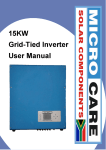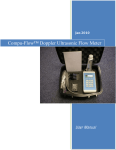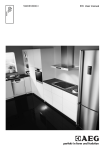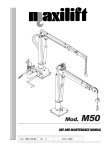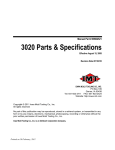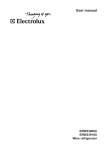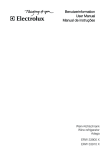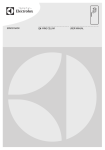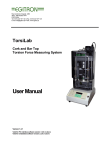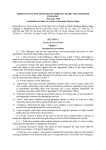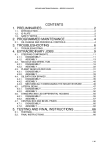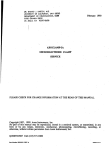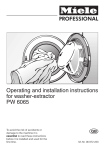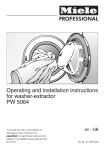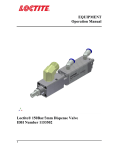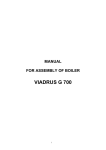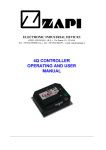Download MD.0.157 GB - MAXILIFT and COBRA Truck Cranes. North Eastern
Transcript
INSTALLATION INSTRUCTIONS USE AND MAINTENANCE MANUAL Boretto Reggio Emilia Italy Code Rev Edition MD.0.157 GB 1 10/08 - Installation instructions for supplementary outriggers - INDEX FOREWORD ........................................................................................................................................... page 1 MACHINE DIRECTIVE ................................................................................................................................ “ 2 REFERENCE NORMS ................................................................................................................................ “ 2 1 2 3 4 5 6 7 7.1 7.2 7.3 7.4 8 9 10 11 11.1 11.2 11.3 11.4 12 12.1 12.2 12.3 12.3.1 12.4 12.5 12.6 12.7 12.8 13 14 15 16 17 MAIN COMPONENTS AND TERMINOLOGY ............................................................................................... “ CYLINDERS FIXING SYSTEMS .................................................................................................................. “ CHOOSING THE STABILIZER .................................................................................................................... “ CALCULATION OF THE MAXIMUM FORCE ALLOWED ON THE STABILIZER ........................................... “ TABLE OF MAXIMUM FORCE RATES ALLOWED ON THE DIFFERENT “MAXISTAB” STABILIZERS ......... “ SUPPLEMENTARY OUTRIGGERS INSTALLATION .................................................................................. “ CHOOSING THE VERSION ....................................................................................................................... “ INSTALLATION ON THE CHASSIS INSTALLATION UNDER THE CHASSIS FIXING SYSTEM BY CLAMP COLLAR FOR SERIES “ ML ” - ” 0 " - “ 1 ” - “ 2 ” - “ 3 ” ............................... “ Supply conditions ....................................................................................................................................... “ Fixing instructions ...................................................................................................................................... “ Warnings and dangers ............................................................................................................................... “ Periodical checkings .................................................................................................................................. “ ASSEMBLING AND DISASSEMBLING OUTRIGGERS CYLINDERS SERIES “ 4 ” STANDARD OR “ P ” VERSION WITH SYSTEM BY STOP RING .............................................................. “ Modification of a stabilizer series “ 4 ” standard version into “ P ” version .............................................. “ FIXING SYSTEM BY SPACER FOR OUTRIGGER CYLINDERS SERIES “ 5 ”, “ 6 ”, “ 7 ”, “ 8 ” ................. “ SPECIAL VERSIONS AND OPTIONALS .................................................................................................... “ “GIR” (tilting) version .................................................................................................................................. “ Swivel foot kit .............................................................................................................................................. “ Cylinders rod extensions ........................................................................................................................... “ Dual side controls kit c/w valve bank ......................................................................................................... “ HYDRAULIC CONNECTION OF “ MAXISTAB ” SUPPLEMENTARY OUTRIGGERS ................................. “ Lock valves on outrigger cylinders ............................................................................................................ “ Connection piping ...................................................................................................................................... “ Prescriptions for “ MAXISTAB ” hydraulic system ...................................................................................... “ Double on-line relief valve ......................................................................................................................... “ Hydraulic scheme for manual extendable stabilizers c/w one valve bank function and “T” connection between crane and additional stabilizers ................................................................. “ Hydraulic scheme for manual extendable stabilizers c/w one valve bank function and 5 ways/4 pos. diverter ......................................................................................................................... “ Hydraulic scheme for hydraulic extendable stabilizers c/w one valve bank function and two 5 ways/4 pos. diverters ................................................................................................................ “ Hydraulic scheme for hydraulic extendable stabilizers c/w two independent 4 functions valve banks (one for the crane and one for the additional stabilizers) .................................................... “ Hydraulic scheme for manual extendable stabilizers c/w two independent 2 functions valve banks ... “ HYDRAULIC CONNECTION OF THE ROD EXTENSION CYLINDERS FOR MODELS “ 1 EHO “ – “ 2 EHO “ ........................................................................................................ “ INSTRUCTIONS FOR FIXING AND CONNECTING THE KIT MICROSWITCHES FOR NOT LOCKED EXTENDABLE RODS ......................................................................................................... “ DECALS APPLICATION .............................................................................................................................. “ STORAGE AND HANDLING INSTRUCTIONS ........................................................................................... “ CAUTIONS TO OBSERVE .......................................................................................................................... “ TABLE OF WEIGHTS W/O PACKING ......................................................................................................... “ FINISHING AND PAINTING OF “ MAXISTAB ” STABILIZERS ..................................................................... “ Via Mediterraneo, 6 - 42022 - Boretto - Reggio Emilia - Italy Tel. +39 - 0522-96 30 08 - Fax +39 - 0522-96 30 39 [email protected] 3 3 5 6 7 8 9 11 11 11 12 13 13 15 15 16 16 16 16 17 18 18 18 18 19 20 21 22 23 24 25 26 27 28 28 29 30 - 18 18.1 18.1.1 18.1.2 18.2 18.2.1 18.2.2 18.2.3 18.2.4 18.3 18.3.1 18.3.2 18.3.3 18.3.4 Use and maintenance manual - STABILIZERS’ USER MANUAL .................................................................................................................. “ Lateral extensions locking systems .......................................................................................................... “ Manually operated lateral extensions ....................................................................................................... “ Hydraulically operated lateral extensions ................................................................................................. “ Operating instructions ............................................................................................................................... “ General attentions ..................................................................................................................................... “ Hydraulic stabilizer ..................................................................................................................................... “ Manually tilting hydraulic stabilizer ............................................................................................................ “ Automatically tilting hydraulic stabilizer ..................................................................................................... “ Regular checks .......................................................................................................................................... “ For all the models ...................................................................................................................................... “ Stabilizer models “ML”, “0”, “1”, “2”, “3” ...................................................................................................... “ Tilting legs models .................................................................................................................................... “ Foot plates on stabilizer legs .................................................................................................................... “ Via Mediterraneo, 6 - 42022 - Boretto - Reggio Emilia - Italy Tel. +39 - 0522-96 30 08 - Fax +39 - 0522-96 30 39 [email protected] 31 31 31 31 32 32 33 33 34 35 35 35 35 35 SUPPLEMENTARY OUTRIGGERS FOREWORD This manual is to be considered as leading the choice and the correct installation on trucks of the Maxistab range of supplementary outriggers. Section 18 includes all the instructions for correct use and maintenance, so these pages can be photocopied and included in the manual that the truck fitting work-shop must consign to the end user according to CE Directives ATTENTION! Every modification or intervention on the base structures of MAXISTAB stabilizers shall have to be agreed with and approved by Next Hydraulics’ Technical Department. Always reed carefully this manual and the “Installation Instructions” of vehicle’s manufacturer before starting installation. Next Hydraulics s.r.l. keeps the right to change its products at any moment without any prior notice. Always make sure to be in possession of the latest release of this manual, and that the prescriptions concerning the models involved in your installation are still in force. -1- Via Mediterraneo, 6 - 42022 - Boretto - Reggio Emilia - Italy Tel. +39 - 0522-96 30 08 - Fax +39 - 0522-96 30 39 [email protected] - Installation instructions for supplementary outriggers - MACHINE DIRECTIVE All the equipments sold within the European Union’s territory must fulfil the regulations of the CEE 98/37 Directive (MACHINE DIRECTIVE) in the version in force. Therefore, each Maxistab stabilizer is fitted with the safety devices required, it bears a plate carrying the CE mark in a visible position, and is delivered accompanied by relevant Conformity Declaration. The installer carrying out mounting, by incorporating the Maxistab stabilizer in the vehicle, produces a new machine: crane (or others) on a vehicle, ready to be put into service. Therefore, he becomes the manufacturer of this new machine, and must comply with the Directive’s provisions concerning design, building, safety in functioning and use. He must keep all of this recorded in the Technical Dossier he is compelled to draw up. After making sure, by proper tests and practical exams, of the correspondence to the requirements, the installer places his own CE plate, and releases his own Conformity Certificate. NOTE We remind that the non-fulfilment to the above involves, in case of accidents: - criminal sanctions - fines (compensation for economic damage caused by defective product) - withdrawal from the market of the machine itself, and in case also of others of the same series. REFERENCE NORMS Directives CEE 98/37, CEE 89/336 and following modifications (91/263 – 92/31 – 93/68). Norm EN 12999 in the version in force. Norm CUNA NC 034-05 (Release 1984), Norm DIN 15019. INSTALLATION AND MOUNTING INSTRUCTIONS, from Manufacturers of various industrial vehicles. Use manuals of hydraulic hoses, from various Manufacturers. Use manuals of hydraulic steel pipes and fittings, from various Manufacturers. Use manuals of pumps and PTO’s, from various Manufacturers. -2- Via Mediterraneo, 6 - 42022 - Boretto - Reggio Emilia - Italy Tel. +39 - 0522-96 30 08 - Fax +39 - 0522-96 30 39 [email protected] - Installation instructions for supplementary outriggers - 1 - MAIN COMPONENTS AND TERMINOLOGY The stabilizer is made of the following parts and main components: (see Pict. 1) 1) 2) 3) 4) 5) 6) 7) 8) 1 Main beam Extendable rod Cylinder sleeve Stabilizer cylinder Foot plate Rod extension cylinder Lock valve Lock assembly for rods 6 2 8 3 Pict. 1 4 7 5 2 - CYLINDERS FIXING SYSTEMS Fixing system by clamp collar (Series 0/ML) (see Pict. 2) 1) 2) 3) 4) 5) 5 3 Clamp collar Tightening nut Hook Fastening screw Cylinder sleeve 4 2 1 Pict. 2 6 Fixing system by clamp collar (Series 1, 2, 3) (see Pict. 3) 1) 2) 3) 4) 5) 6) 5 4 Clamp collar Tightening nut Hook Screw eye Lock nut Cylinder sleeve 3 2 1 Pict. 3 Via Mediterraneo, 6 - 42022 - Boretto - Reggio Emilia - Italy Tel. +39 - 0522-96 30 08 - Fax +39 - 0522-96 30 39 [email protected] -3- - Installation instructions for supplementary outriggers - Fixing system by stop ring (Series 4) (see Pict. 4) 3 1) 2) 3) 4) 5) 6) 1 6 Stop ring (stop round bar) Cylinder sleeve Slit Cylinder groove Hooking hole Security dowel 4 NORMAL "P" VERSION 2 5 Pict. 4 3 Fixing system by spacer (Series 5, 6, 7, 8) (see Pict. 5) 1) 2) 3) 4) 5) 2 1 Spacer Plate Ring nut Security dowel Cylinder sleeve 4 5 Pict. 5 -4- Via Mediterraneo, 6 - 42022 - Boretto - Reggio Emilia - Italy Tel. +39 - 0522-96 30 08 - Fax +39 - 0522-96 30 39 [email protected] - Installation instructions for supplementary outriggers - 3 - CHOOSING THE STABILIZER The MAXISTAB range of stabilizers is additional for cranes which already have their own stabilizers, when the stability of the vehicle is not sufficient. In case the vehicle on which a crane is installed is smaller than the minimum vehicle foreseen by the manufacturer for that kind of crane, it will be necessary to install an additional stabilizer. The choice of the additional stabilizer is to be made according to two main factors: 1) The stability checking of the vehicle with crane at full load and in the most unfavourable conditions 2) The maximum force which has to be borne by the additional stabilizer. Each crane manufacturer gives some indications, which you can refer to, for the stability calculation of the vehicle with crane installed. In case of use or installation as main stabilizer near to cranes, aerial platforms or for other employments, in order to guarantee the stability of the vehicle, the installer has to calculate the stability of the system and the actual stress the stabilizer will be subjected to, by following the calculation systems imposed by the regulations in force, and making sure that the max. stress borne by the stabilizer is lower than the rates indicated in the table at page 7. Anyway, in the MAXISTAB range you can choose among the following stabilizer models: - Type "EMO" "EHO" Type "F" Type Type "EMA" "EHA" "EXHA" fixed (F) extendable with opposite rods (EMO/EHO) Pict. 6 extendable with side-by-side rods (EMA/EHA/ELHA) extendable with two telescopic extensions each side (EXHA/EXPHA) (see Pict. 6). As far as the choice of stabilizer size or type according to crane lifting moment is concerned, it is important to remember that the moment rates mentioned in the range brochure are only an indication, as they cannot consider the real distance of the stabilizer from the crane, or the actual dynamic moment of the crane itself. Therefore, in order to make a correct choice, please follow the calculation system shown at page 6. Via Mediterraneo, 6 - 42022 - Boretto - Reggio Emilia - Italy Tel. +39 - 0522-96 30 08 - Fax +39 - 0522-96 30 39 [email protected] -5- - Installation instructions for supplementary outriggers - 4 - CALCULATION OF THE MAXIMUM FORCE ALLOWED ON THE STABILIZER 1) Column axle offset from the middle of the vehicle to the left or to the right (cm) 2) Longitudinal distance from column centre to the middle of the additional stabilizer, or to the middle of the closest stabilizer cylinder in case of stabilizer with side-by-side rods (cm) 3) Maximum dynamic moment of the crane stated by its manufacturer (daNm). Filing up the two equations in pict. 7 with the above data, the maximum force allowed on the cylinder is drawn. Compare such data with the attached table of maximum allowed force rates, and check that it is lower, i.e.: R max < R allowed If not so, repeat the calculation after increasing the stabilizer distance from the crane (if possible), or choose a stabilizer with a bigger spread, or opt for the stabilizer with the immediately higher capacity. H (cm) = (C/2-S)2 +L2 Rmax(daN) = M max H Where: M max. (daNcm) C (cm) L (cm) = Max. dynamic crane moment = Max. spread of additional stabilizer = Longitudinal distance between column axle and additional stabilizer Pict. 7 -6- Via Mediterraneo, 6 - 42022 - Boretto - Reggio Emilia - Italy Tel. +39 - 0522-96 30 08 - Fax +39 - 0522-96 30 39 [email protected] - Installation instructions for supplementary outriggers - TABLE OF MAXIMUM FORCE RATES ALLOWED ON THE DIFFERENT “MAXISTAB” STABILIZERS TYPE R allowed (daN) (Lbs) ML-F 2400 5300 ML-E 1560 0F TYPE R allowed (daN) (Lbs) 3 EHA 10500 23100 3450 4 EHA 14000 30800 3000 6600 5 EHA 17750 39000 0 EMO 3000 6600 5 ELHA 19700 43300 1F 6300 13850 5 EXHA 17800 39100 1 EMO 6300 13850 5 EXPHA 15000 33000 1 EHO 6300 13850 6 EXHA 21500 47300 1 EMA 6150 13550 6 EXPHA 19000 41800 1 EHA 6150 13550 7 EXPHA 25000 55000 2F 8250 18150 8 EXPHA 28000 61600 2 EMO 9000 19800 2 EHO 9000 19800 2 EMA 9000 19800 2 EHA 9000 19800 ATTENTION! Please remember that the rates mentioned in this table concern the structural resistance of the stabilizer, and do not consider the consistency of the ground on which the vehicle has to work. Especially for those stabilizers whose max. allowed force is very high, we suggest always to foresee during the installation a housing where to store two outrigger pads for weight distribution with proper surface and resistance, as well as to prescribe their use to the customer in the Technical Booklet. Via Mediterraneo, 6 - 42022 - Boretto - Reggio Emilia - Italy Tel. +39 - 0522-96 30 08 - Fax +39 - 0522-96 30 39 [email protected] -7- - Installation instructions for supplementary outriggers - 5 - SUPPLEMENTARY OUTRIGGERS INSTALLATION The supplementary outriggers can be installed in the following ways: On the chassis by welding the stabilizer to the edge of the counter-frame, or by cutting the same and inserting the stabilizer in an opening made in a middle point of the counter-frame itself. At this stage it will be necessary to fix adequately the counter-frame and the stabilizer to the vehicle chassis by side plates and fixing screws. (see Pict. 8) Counter-frame Chassis Opening for stabilizer Pict. 8 Under the vehicle chassis In this case, the stabilizer is to be fixed to the chassis and the counter-frame by means of brackets welded to the stabilizer itself, with counter-plates to be fixed by screws to the chassis or the counter frame. It is important that the stabilizer leans against the chassis without clearance and in vertical position. The chassis must be reinforced by a suitable counter-frame supporting the same according to the indications of the crane or the vehicle manufacturer. (see Pict. 9) Piping side Apart from the solution chosen, the stabilizer installation must always fulfil the following essential conditions: -8- Via Mediterraneo, 6 - 42022 - Boretto - Reggio Emilia - Italy Tel. +39 - 0522-96 30 08 - Fax +39 - 0522-96 30 39 [email protected] Pict. 9 - Installation instructions for supplementary outriggers - a) b) c) d) e) the manually operated pins and hookings, the extendable rod handles, the levers of the manual lock valves are always to be easily accessible, and their operation must entail no risk for the user the hydraulic hoses close to the operator must always be properly protected and shielded check that there are no piping or wires pending or protruding under the stabilizer, with following risk of entangling when travelling. When necessary, collect them by means of clamps, sheaths, etc., and fasten them properly to some fixed parts for hydraulic extendable stabilizers, make sure of the correct functioning of the side extension system, and check in particular that the mobile parts (such as rods, piping, wires, etc.), when moving, do not interfere of get entangled with other fixed parts of the vehicle or the stabilizer for the manually tilting stabilizers, make sure that relevant operations can be easily and safely carried out. 6 - CHOOSING THE VERSION According to the type of installation adopted, you have to choose the right version of additional stabilizer. INSTALLATION ON THE CHASSIS If the installation is to be made on the chassis, normally you choose stabilizers with standard or long stabilizer cylinders. Only in exceptional cases you will have to choose the “S” versions with short cylinders. From series ML/0 up to series 3 The stabilizers in “K” version from series ML/0 up to series 3, which are already shipped in standard version, checking excepted, are ready for installation. In case, when extending the rods, the cylinder or the fitting protection interfere with the body side box, it is possible to lower the cylinder, keeping it aligned in the upper part of the cylinder sleeve, as mentioned in § 7.3 (Pict. 14). Series 4 For the stabilizers of series 4 it will be necessary to check if you require the “S” version with short cylinders, or the standard version, by looking at the sizes of each type in the catalogue. Series 5-6-7-8 For the stabilizer series 5-6-7-8 type EXHA or EXPHA, first it will be necessary to check if you have to use the “S” versions with short cylinders, or the “L” version with long ones. Then, in case, you can consider the AR versions (to be always originally ordered), which make the stabilizer cylinders move 200mm downwards. For the models 5 EHA – 5 ELHA, which can be supplied both in “S” or “L” version too, the AR option (to be always originally ordered) makes the stabilizer cylinders move upwards of about 60mm, and consequently it is more suitable for installation under the chassis. INSTALLATION UNDER THE CHASSIS In case you wish to install the stabilizer under the chassis, you will have to make your choice in the following way, according to the different fixing systems foreseen for stabilizer cylinders. Via Mediterraneo, 6 - 42022 - Boretto - Reggio Emilia - Italy Tel. +39 - 0522-96 30 08 - Fax +39 - 0522-96 30 39 [email protected] -9- - Installation instructions for supplementary outriggers From series ML/0 up to series 3 Stabilizers series ML-0-1-2-3: you will have to choose among the several versions according to the length of the cylinders, which anyway will have to be moved upwards by following the instructions at § 7. The installer will have to secure again the clamp collars in the position suitable to allow the stabilization, and to prevent cylinders interference with the body side boxes during the extension operation. Series 4 Stabilizers series 4: you will have to choose a stabilizer in “P” version with standard or short (“S”) cylinders, checking that the size “R” and the stroke “E” in the catalogue allow the correct stabilization. On request before ordering, it is possible to have the cylinders in a 100 mm lower position compared to the size “R” in the catalogue. Check that the size “U” does not cause interferences of the cylinder with the body. Sometimes it could be necessary to consider the AR (overturned rods) version, which allows to move the cylinder more upwards, in case you need to recover some space from the ground, and the room above the stabilizer makes this operation feasible. Series 5-6-7-8 Except for special cases, in this type of application you have to use the versions ****/S-P, which grant the min. dimensions under the vehicle chassis (size “R”). The AR option (to be always originally ordered) moves the cylinders 200mm downwards in models *EXHA - *EXPHA in comparison to the corresponding standard version. For models 5 EHA – 5 ELHA the AR option (to be always originally ordered) moves the stabilizer cylinders 60mm upwards in comparison to the corresponding standard version. All these different possibilities grant innumerable combinations of application features, which make the product suitable for the most various requirements. In some cases you could use the “S” versions as well for installation under the chassis, in the presence of vehicles with considerably high frames. Arrangement of supporting tubes for hoses, on models from 1EMA to 5 EHA The standard, ex works, arrangement for the stabilizer cylinders, their hoses and supporting tubes, is shown on pict. 10A. When is necessary to move the cylinders upwards, the supporting tubes must be modified to enable the repositioning of the cylinders and their hoses to run and move free of any obstruction. Procedure: ¾ Loose the anti-rotating lock (1) of the cylinder. ¾ Rotate the cylinder toward the outer side of the beam, until the supporting tubes (2) and relevant hoses enable the cylinder itself to be moved upwards freely, without getting stuck on the outer part (3) of the main beam. ¾ Put a mark on the supporting tube, on point (4) where the tube will be bent, then measure with a a goniometer the bending angle required to bring the tube parallel to the main beam in the new required configuration (ref pict. 10B). ¾ Disassemble the supporting tube from the valve, by loosening bolts (5). 4 ¾ Bend the tube at the required angle, then mount it again on the valve and secure the hoses to it. ¾ Repeat procedure on each side of the stabilizer. - 10 - 3 A Via Mediterraneo, 6 - 42022 - Boretto - Reggio Emilia - Italy Tel. +39 - 0522-96 30 08 - Fax +39 - 0522-96 30 39 [email protected] 1 2 5 B Pict. 10 - Installation instructions for supplementary outriggers - 7 - FIXING SYSTEM BY CLAMP COLLAR FOR SERIES “ML” – “0” – “1” – “2” – “3” 7.1 Supply conditions The stabilizer is supplied with outrigger cylinders already fixed in the position shown in Pict. 11, and locked in a way which does not require any further operation to be carried out by the installer, in case such position is suitable for the type of mounting. IMPORTANT Should cylinder position need to be different, the installer must conform scrupulously to the below described instructions Pict. 11 7.2 Fixing instructions In case you want to change cylinder position in comparison to the one it has been supplied in, first of all you have to unscrew the lock nut (1) (Pict. 12) of the fall and slewing preventing system; therefore it is necessary to pay attention to the accidental and uncontrolled descent of the cylinder itself, which may cause limbs crushing. Concerning cylinders of series “0”/”ML”, please refer to Pict. 12a. - Unscrew the locking screw (2) of the clamp (3), and pull it out, consequently releasing also the coupling (4). In order to open wide the collar, you have to screw the screw (2) from the threaded side (Pict. 13), placing a shim or the coupling itself in the split. Let the collar slide up to the desired position, and lock it unscrewing the screw previously fitted in. Put the screw (2) back into its original position, slipping it into the hole of the adjustable coupling (4) inserted in the split. Let the cylinder slide upwards (Pict. 14), until the collar leans against the cylinder sleeve, so that the threaded shank of the coupling (4) slips into the eyelet (5), and can be locked by tightening the lock nut (1). 1 5 4 3 2 Pict. 12 4 1 3 Via Mediterraneo, 6 - 42022 - Boretto - Reggio Emilia - Italy Tel. +39 - 0522-96 30 08 - Fax +39 - 0522-96 30 39 [email protected] 2 Pict. 12a - 11 - - Installation instructions for supplementary outriggers - Tighten slightly the screw (2), paying attention that the collar is completely leaning to the below part of the cylinder sleeve, in case helping by some slight rebound-proof mallet strokes. - Then tighten definitively the screw by the torque wrench to the driving torque shown in the proper table (Tab. 1). Table 1 Stabilizer Cylinder Screw type Wrench model diameter(mm) (mm) (mm) GR. 0/ML 70 Gr. 1 85 Gr. 2 / Gr. 3 95 TCEI M12 cl. 12.9 TCEI M14 cl. 12.9 TCEI M16 cl. 12.9 Driving torque 10 daN-m 12 Lbs-ft 85 12 20 145 14 30 220 Pict. 13 7.3 Warnings and dangers Pict. 14 1. 2. 3. 4. 5. The non-respect of tightening torques puts at risk stabilizer’s safety. Before tightening, check that the screw and its threaded hole made in the collar are degreased and clean. Check that in the new working position chosen, YES the stabilizer cylinder is still correctly housed into its cylinder sleeve. That happens when the cylinder leans on both centering bands made inside the sleeve (Pict. 15). If during the above operations the sharp profiles made in the internal cylindrical surface of the collar are accidentally damaged, take care of replacing the collar by a new one. The collar must not be welded in any way. The prescription decal, indicating the obligation to use the torque wrench, and the driving torque value, is to be applied near the collar after the installation is finished, and anyway after painting, so that it is completely visible. - 12 - Via Mediterraneo, 6 - 42022 - Boretto - Reggio Emilia - Italy Tel. +39 - 0522-96 30 08 - Fax +39 - 0522-96 30 39 [email protected] NO Pict. 15 - Installation instructions for supplementary outriggers - 7.4 Periodical checking - Weekly: Carry out a visual checking making sure that the cylinders did not move upwards or that, with cylinders in transport position, there is no clearance between the locking collar and the sleeve; in case one of the above situations occurs, have screw tightening checked by an authorized workshop. Yearly: Have screw tightening checked by an authorized workshop and, if necessary, restore it tightening by torque wrench, according to what shown in Tab. 1. - Each operation beyond what described has always to be approved by Next Hydraulics’ Technical Department, whom you have to apply to for any clarification and further information required. 8 - ASSEMBLING AND DISASSEMBLING OUTRIGGER CYLINDERS SERIES “4” STANDARD OR “P” VERSION WITH SYSTEM BY STOP RING Assembly (see Pict. 16-17) STEPS 1) 2) 3) 4) 5) 6) 7) Take the new stop round bar (1) and bend it slightly ASSEMBLY close to the hooking notch (drawing) Grease by a brush the Bend slightly cylinder sleeve and the cylinder liner in the area where it slips into the Grease sleeve Slip the cylinder into the DISASSEMBLY seat until the groove and 1/2"gas the hooking hole coincide with the slit in the front of L= ~6 00 the cylinder sleeve mm Hook the stop round bar, grease it and screw by the lever (3) until everything is in its place, and setting the fittings inlets in the desired position 1/2"gas Lock the rotation by the L= 3/8"gas ~6 00 dowel (2); use Loctite 242 mm to prevent unscrewing Degrease the outside and seal the “A” and “B” areas Pict. 16 by silicone (black Saratoga for bodywork). Assemble all fittings. Both greasing and protection against possible water seepages are important for an easy disassembly. Via Mediterraneo, 6 - 42022 - Boretto - Reggio Emilia - Italy Tel. +39 - 0522-96 30 08 - Fax +39 - 0522-96 30 39 [email protected] - 13 - - Installation instructions for supplementary outriggers IMPORTANT For a following easy disassembly, it is important to be particularly careful during the greasing and sealing operations, in order to grant an effective protection against water seepages. Disassembly (see Pict. 16-17) STEPS 1) 2) 3) 4) 5) 6) Disassemble cylinder piping, which inhibit its extraction Remove the sealing silicone from the “A” and “B” areas Unscrew the dowel (2), in order to release the cylinder Insert the lever (3) for the disassembly; make the cylinder turn until the end of the stop round bar (1) comes in correspondence of the slit on the sleeve Lever by a screwdriver, so that the round bar, going on turning, comes out of the slit At this stage, when the round bar is out, the cylinder can be extracted. DISASSEMBLY ASSEMBLY Bend slightly Grease L= ~6 00 mm 1/2"gas L= ~6 00 mm 1/2"gas L. to be defined Pict. 17 IMPORTANT For a following easy disassembly, it is important to be particularly careful during the greasing and sealing operations, in order to grant an effective protection against water seepages. - 14 - Via Mediterraneo, 6 - 42022 - Boretto - Reggio Emilia - Italy Tel. +39 - 0522-96 30 08 - Fax +39 - 0522-96 30 39 [email protected] - Installation instructions for supplementary outriggers - 9 -Modification of a stabilizer series “4” standard version into “P” version (with system by stop ring – see Pict. 16) After the cylinder have been disassembled by following the above mentioned instructions, you have to carry out the following operations: 1) 2) 3) Put the cylinder on the lathe, and make a groove in the desired position with same dimensions of the one already existing on the bottom, depth 2.5 mm, R 2.6 mm, by a tool of proper radius In case turn the cylinder liner to the nominal diameter (if necessary) for a length of 200-210 mm beyond the groove made Drill by a flat centre a hole Ø 5.25 in the middle of the groove, lined up to the fittings. The depth of the hole must not exceed 5.5 – 6 mm. ATTENTION! The thickness of the cylinder liner is 7.5 mm. After this operation, you can go on with the assembly by following the above mentioned instructions. 10 - FIXING SYSTEM BY SPACER FOR OUTRIGGER CYLINDERS SERIES “5” – ”6" – “7” – “8” In case of standard installation, the force develops on the spacer (1) placed between the lower surface of the cylinder sleeve (2) and the beat made on the cylinder collar (3). In case of installation under the chassis (P version), the force is developed from the direct contact between the cylinder collar beat and the lower surface of the cylinder sleeve. The fixing is fulfilled by slipping the spacer on the cylinder, whose collar is already beating on the cylinder sleeve lower part, stopping the system by the plate (4) and screwing the ring nut (5) on the threaded tang on cylinder bottom. Then the cylinder is locked by screwing the dowel (6), which prevents rotation, in the threaded hole of the sleeve. In order to fulfil an intermediate positioning in comparison to the above mentioned two, you have to cut the spacer. The steps to follow for disassembly in this case, or in case you wish to change cylinder position compared to the one it has originally been delivered into, are the following: a) Remove fittings protection b) Disassemble the piping c) Unscrew the elbow union on cylinder bottom d) Before unscrewing the ring nut, you have to support the cylinder by proper means, in order to prevent its accidental and uncontrolled descent, which can cause limbs crushing e) Unscrew the ring nut, in order to release the plate f) Unscrew the rotating preventing dowel g) Extract the cylinder and the spacer Via Mediterraneo, 6 - 42022 - Boretto - Reggio Emilia - Italy Tel. +39 - 0522-96 30 08 - Fax +39 - 0522-96 30 39 [email protected] 5 4 1 2 6 3 Pict. 18 - 15 - - Installation instructions for supplementary outriggers - 11 - SPECIAL VERSIONS AND OPTIONALS The MAXISTAB stabilizers can be provided with some optionals which can solve problems related to difficult or particular installations. 11.1 “GIR” (tilting) version This version is to be specified on order, and has got slewing cylinders, which can pivot on a pin, with the possibility of pegging the cylinders in transport position to different angles compared to the vertical line. Normally, the standard positions are 45° and 180°. This version is chosen when you require a reasonable stroke of the stabilizer cylinders, but their overall dimensions are excessive and they cannot stay in vertical position, or when there are some cumbersome parts on the vehicle, which do not allow the correct placing in vertical transport position of the cylinders. Conversions into this version starting from standard stabilizers are not possible. This version is to be originally ordered. 11.2 Swivel foot kit It is installed as standard on the biggest models starting from series 3, and it helps preventing bending stresses on cylinder rods, in case the foot plate bearing surface is not completely flat. It can be requested as optional also on series ML-0-1. 11.3 Cylinders rod extensions Such optionals are used in case you realize that the fully extended stabilizer cylinders are not able to stabilize sufficiently the vehicle. They are normally threaded male-female, and can be mounted by placing them between rod and foot plate, screwing them thoroughly and locking them up and down by a dowel. Next Hydraulics is able to supply optional rod extensions, whose dimensions are mentioned in the MAXISTAB catalogue. The dimensions, the mounting procedure and the materials they are made of ensure their suitability for installation on our stabilizers. ! ATTENTION - DANGER The application of rod extensions to the stabilizer cylinders is to be made with extreme care, as in general it implies an increase of stresses on the rods, with following danger of inflection and unexpected yielding of the same, and consequent risk for the stability of the vehicle. Before applying non-original extensions, always consult Next Hydraulics, in order to check whether they are suitable and correctly mounted. In particular, in case of extensions applied by welding (operation to avoid as far as possible), before welding the extension to the rod you must always fully extend the rod itself up to its stroke end, in order to prevent the burning of cylinder head seals. All cylinders leaking oil owing to the inobservance of such basic precaution are not acknowledged under warranty. - 16 - Via Mediterraneo, 6 - 42022 - Boretto - Reggio Emilia - Italy Tel. +39 - 0522-96 30 08 - Fax +39 - 0522-96 30 39 [email protected] - Installation instructions for supplementary outriggers - 11.4 Dual side controls kit c/w valve bank This kit is used in case you wish to operate the rear stabilizer directly by a valve bank installed on it. Normally the hoses for connection to the cylinders and the valve bank pass under the stabilizer, and are suitable for installation under the chassis. If you want to install the stabilizer on the chassis, this must be specified on order, so that the original run of the hoses can be modified. There are 3 available types of dual side controls kits: A) for stabilizers c/w hydraulically extendable side-byside rods B) for stabilizers c/w hydraulically extendable opposite rods C) for fixed or manually extendable stabilizers. The operation levers are arranged in order to allow only the operation of the functions related to their location side. (see Pict. 19) ! ATTENTION The distributor valve bank is supplied with a standard preset value of 80 bar on its main relief valve. Some models of stabilizers (see Table 2) require a setting of 150 bar on the section directing the lateral beam extension. In these cases adjust the main relief valve (checking the pressure with a manometer gauge on the P port) until the desired value is achieved. Pict. 19 Via Mediterraneo, 6 - 42022 - Boretto - Reggio Emilia - Italy Tel. +39 - 0522-96 30 08 - Fax +39 - 0522-96 30 39 [email protected] - 17 - - Installation instructions for supplementary outriggers - 12 - HYDRAULIC CONNECTION OF “MAXISTAB” SUPPLEMENTARY OUTRIGGERS The MAXISTAB stabilizers are supplied equipped with their own installed hydraulic circuit. Piping is interrupted and open in the middle of the stabilizer itself, in order to allow the connection to the hydraulic feeding circuit, according to different schemes which are left to the installer’s preference. Even within such power of discretion, for safety reasons and regulations, it is essential that the control hydraulic circuit can be operated on both sides of the vehicle, so that the operations concerning stabilizer rods extension and stabilizer cylinders lowering on the ground are always visible during their execution. In the following pages (Pict. 22-23-24-25-26) are shown as an example the schemes of some hydraulic circuits for the connection to MAXISTAB stabilizers. ATTENTION Whatever the type of circuit chosen is, you have to make sure of connecting always the bottom side of one stabilizer cylinder with the bottom side of the other one, and consequently also the rod side of the first one with the rod side of the other one (compare the pict. 22-23-24-25-26). Otherwise, when putting into service for the first time, the overpressure caused by the wrong connection will result in the immediate breaking of one of the cylinder heads, without any warranty acknowledgement by Next Hydraulics. In Section13, is shown the connection scheme for the supply of the rod extensions cylinders for MAXISTAB models 1 EHO and 2 EHO. We hereby recall some information and warnings. 12.1 Lock valves on outrigger cylinders All stabilizers starting from series 2 inclusive onwards are fitted with standard double acting lock valves, while all stabilizers of series ML, 0 and 1 are fitted with simple acting manual lock valves. NOTE: in case the crane valve bank is a so called “open centre” type, the stabilizers lock valves need to be double acting. In case of order of stabilizers series ML, 0 or 1, this is to be specified when placing it. 12.2 Connection piping The connection piping to the hydraulic circuit of MAXISTAB stabilizers can be either a steel stiff type or rubber hoses with steel plaits, but always of a type suitable for high pressure hydraulics. The internal diameters, materials and thicknesses must be suitable to circuit pressures and circulating oil flow. About this we suggest to follow the EN 12999 prescriptions. 12.3 Prescriptions for Maxistab hydraulic system Locking pins and safety automatic latches against accidental coming out of the lateral extension beams must be protected from damage by limiting the pressure on bottom side of the extension cylinders (ref. picts. 12.6, 12.7). It is also required that spools of the “closed center” type are fitted on the sections of the distributor valvebank that controls lateral extensions (ref. again picts 12.6, 12.7). Follow TABLE 2 for the maximum allowable pressures on these sections for every model of Maxistab range. These values are also written on the yellow decal labels applied on every stabilizer beam nearby the ports of the extension cylinders (as shown on pict. 20). A relief valve able to limit the pressure on the lateral extensions cylinders, is available and its features are shown in the following section 12.3.1. - 18 - Via Mediterraneo, 6 - 42022 - Boretto - Reggio Emilia - Italy Tel. +39 - 0522-96 30 08 - Fax +39 - 0522-96 30 39 [email protected] - Installation instructions for supplementary outriggers The maximum working pressure for the Maxistab range hydraulic system is 300 bar. In case of higher pressure, always apply to Next Hydraulics tech. dept for approval. Table 2 MOD EL Max. w orking pressure on bottom side of lateral extens. cylinders [bar] 1 1 2 2 EHO EHA EHO EHA 3 4 5 5 5 6 6 7 8 EHA EHA EHA EXHA EXPHA EXHA EXPHA EXPHA EXPHA 80 150 12.3.1 Double on-line relief valve This valve (ref. pict. 21) has a maximum working pressure of 350 bar and a max oil flow of 80 liters/min. When connect the bottom ports of extension cylinders to the valve ports V1 and V2, the pressure in these sides will be limited to a value (factory pre-set) of 80 bar. When required according to TABLE 2, this value may be raised to 150 bar by tightening the screws on the cartridges. Whilst doing this, carefully check the new set value by mean of a manometer gauge. The valve port T must be connected to the oil tank. V1 T V2 V2 V2 V1 G 1/2” BSP G 1/2” BSP V1 Pict. 20 T G 1/2” BSP Pict. 21 In the next pages various examples of possible hydraulic diagrams for stabilizers connections are shown. Via Mediterraneo, 6 - 42022 - Boretto - Reggio Emilia - Italy Tel. +39 - 0522-96 30 08 - Fax +39 - 0522-96 30 39 [email protected] - 19 - - Installation instructions for supplementary outriggers - 12.4 Hydraulic scheme for manual extendable stabilizers c/w one valve bank function and “T” connection between crane and additional stabilizers Additional stabilizer 4 4 2 2 Main crane stabilizer 3 3 2 2 1 V Max 1) 2) 3) 4) 150 bar Control valve bank Lock valve Crane stabilizer cylinder Supplementary stabilizer cylinder - 20 - Via Mediterraneo, 6 - 42022 - Boretto - Reggio Emilia - Italy Tel. +39 - 0522-96 30 08 - Fax +39 - 0522-96 30 39 [email protected] Pict. 22 - Installation instructions for supplementary outriggers - 12.5 Hydraulic scheme for manual extendable stabilizers c/w one valve bank function and 5 ways/4 pos. diverter Alternative: manually operated lock valve Additional stabilizer 5 5 2 2 Main crane stabilizer 3 3 2 2 4 1 V max 150 bar 1) 2) 3) 4) 5) Control valve bank Lock valve Crane stabilizer cylinder Diverter Supplementary stabilizer cylinder Via Mediterraneo, 6 - 42022 - Boretto - Reggio Emilia - Italy Tel. +39 - 0522-96 30 08 - Fax +39 - 0522-96 30 39 [email protected] Pict. 23 - 21 - - Installation instructions for supplementary outriggers - 12.6 Hydraulic scheme for hydraulic extendable stabilizers c/w one valve bank function and two 5 ways/4 pos. diverters Alternative: manually operated lock valve 8 8 Additional stabilizer 7 7 9 9 4 4 6 5 5 3 Main crane stabilizer 3 4 4 2 1 V max 150 bar 1) 2) 3) 4) 5) Control valve bank Crane stabilizer diverter Crane stabilizer cylinder Lock valve Crane stabilizer extension cylinder - 22 - 6) 7) 8) 9) Additional stabilizer diverter Additional stabilizer cylinder Additional stabilizer extension cylinder Relief valve (see Table 2) Via Mediterraneo, 6 - 42022 - Boretto - Reggio Emilia - Italy Tel. +39 - 0522-96 30 08 - Fax +39 - 0522-96 30 39 [email protected] Pict . 24 - Installation instructions for supplementary outriggers - 12.7 Hydraulic scheme for hydraulic extendable stabilizers c/w two independent 4 functions valve banks (one for the crane and one for the additional stabilizers) Alternative: manually operated lock valve 7 7 Additional stabilizer 6 6 2 2 4 Main crane stabilizer 4 1 1 2 2 3 5 V max 150bar p max p max 150bar p max: see Table 2 1) 2) 3) 4) 5) 6) 7) Crane stabilizer cylinder Lock valve Crane stabilizer valve bank Crane stabilizer extension cylinder Additional stabilizer valve bank Additional stabilizer cylinder Additional stabilizer extension cylinder Via Mediterraneo, 6 - 42022 - Boretto - Reggio Emilia - Italy Tel. +39 - 0522-96 30 08 - Fax +39 - 0522-96 30 39 [email protected] Pict. 25 - 23 - - Installation instructions for supplementary outriggers - 12.8 Hydraulic scheme for manual extendable stabilizers c/w two independent 2 functions valve banks Alternative: manually operated lock valve Additional stabilizer 5 5 2 2 Main crane stabilizer 1 1 2 2 3 4 V max 150bar 1) 2) 3) 4) 5) Crane stabilizer cylinder Lock valve Crane stabilizer valve bank Additional stabilizer valve bank Additional stabilizer cylinder - 24 - Via Mediterraneo, 6 - 42022 - Boretto - Reggio Emilia - Italy Tel. +39 - 0522-96 30 08 - Fax +39 - 0522-96 30 39 [email protected] 150bar Pict. 26 - Installation instructions for supplementary outriggers - 13 - HYDRAULIC CONNECTION OF THE ROD EXTENSION CYLINDERS FOR MODELS “1 EHO” – “2 EHO” In picture 27 are shown the connection inlets for the rod extension cylinders, in order to make the correct mounting easier. C A D B B A C D B A C D Via Mediterraneo, 6 - 42022 - Boretto - Reggio Emilia - Italy Tel. +39 - 0522-96 30 08 - Fax +39 - 0522-96 30 39 [email protected] Pict. 27 - 25 - - Installation instructions for supplementary outriggers 14 - INSTRUCTIONS FOR FIXING AND CONNECTING THE KIT MICROSWITCHES FOR NOT LOCKED EXTENDABLE RODS The kit warns the driver, when manually operated extension rods are not locked in the transport position. That kit is to be ordered separately, and is supplied with instructions sheet. WIRING INSTRUCTIONS (Pict. 28): Microswitches (1) e (2) of the supplementary outrigger must be normally open (NO) and series connected each other, by means of the bus bar (3). Should the extensions of the crane main stabilizer be manually operated, also their microswitches (4) and (5) will have to be normally open (NO) and series connected each other and with the previous ones, layed on the line supplying the solenoid of the relay (6). The contact (7), controlled by the relay, must be normally closed (NC) on the line supplying the warning light (8) in the driver’s cab, and series connected with the truck ignition key (9). The warning light must be a RED lamp or LED. FITTING OF THE COMPONENTS (Pict. 29): 3 1 2 9 4 6 5 7 8 Pict. 28 Place the plate (1) on the centreline of the main beam, on the vertical wall. Then, fix it with two small welds through holes (3). ¾ Following the contour of the plate (1), apply a silicone bead to avoid penetration between and subsequent formation of rust. ¾ Drill the wiring box (2), with three ø19 holes (4) as shown in pict. 29. ¾ Fix the wiring box (2) on the plate, using the two screws (5), through holes (6). ¾ Fit the holes (4) with relevant wire clamps (7) and secure them with relevant counternuts (8). ¾ Mount, on each side of the beam, the two microswitches (11), fixing along with their spacer (13) on the locking latches (12) by means of bolts (9)+(10) securing with soft loctite on their threads. ¾ Drive the free end of the microswitches wires (14) into the box through the wire clamps (7). ¾ Connect wires on the bus bar (15) following to the wirings shown in pict. 28. ¾ Apply the self-adhesive clips (16) on the beam. ¾ Secure the wires (14) to the adhesive clips (16), using cable ties (17). ¾ Tighten the caps (18) on every wire clamp (7). ¾ Close the box (2) with its cover (19), tightening the screws (20). ¾ Pict. 29 FINAL CHECKINGS: With the truck ignition key turned ON: The red lamp in the driver’s cab must be switched OFF when both lateral extensions are locked. The red lamp must be light ON if one or both the lateral extensions are not locked. - 26 - Via Mediterraneo, 6 - 42022 - Boretto - Reggio Emilia - Italy Tel. +39 - 0522-96 30 08 - Fax +39 - 0522-96 30 39 [email protected] - Installation instructions for supplementary outriggers - 15 - DECALS APPLICATION Version: 4-EHA 5-EHA 5-ELHA 5-EXHA 6-EXHA 5-EXPHA 6-EXPHA 7-EXPHA 8-EXPHA version with automatic lock valve Pict. 30 Each MAXISTAB stabilizer is equipped with a sealed envelope holding the decals and the safety warnings required. Such decal kit must be applied to the stabilizer, after its final painting, as shown in pict. 30. When delivering the stabilizer to the end customer, always make sure that it is fitted with all the warnings and decals shown in the picture. If not so, apply to Next Hydraulics for the missing ones. Via Mediterraneo, 6 - 42022 - Boretto - Reggio Emilia - Italy Tel. +39 - 0522-96 30 08 - Fax +39 - 0522-96 30 39 [email protected] - 27 - - Installation instructions for supplementary outriggers - 16 - STORAGE AND HANDLING INSTRUCTIONS The MAXISTAB stabilizers can be delivered to the installer on different sorts of packing, generally pallets or wooden frame suitable for handling by forklifts or transpallets. Each stabilizer is supplied along with: - CE Conformity Declaration - decal kit as described in Section 15. On the receipt, always make sure that all of the above material has arrived, and that the stabilizer and its more exposed parts (piping, valves, hookings, etc.) did not get damaged in transport. In case of doubts about some parts efficiency and functionality, remove them and agree with Next Hydraulics on their replacement. Storage must be carried out in a covered and dry place, especially if you do not expect to use the product for quite a long time. Anyway bear in mind that, after long storage periods (12 months or more, depending also on the environmental conditions), some anomalies could occur when putting into service for the first time, due to the sticking of the seals of rods, valves cursors, etc. for long inactivity. CAUTIONS TO OBSERVE As a simple and not exhaustive example, we hereby report some basic precautions regarding the installation operations: 1] locate and delimit the area appointed for mounting, keeping it clear from the transit of other machines, equipments, personnel 2] avoid any welding operation, or free flames in narrow or not adequately aired places, or close to inflammables 3] be careful when entering (or slipping some parts of the body) in narrow spaces 4] pay attention to dangers and risks coming from parts in motion, toxicants or corroding substances (for instance: batteries acids) and fluids under pressure 5] always use clothes conform to the accident preventing norms 6] all the machines or some of their parts, or other equipments lifted from the ground, or which might cause crushing or shearing, must be safely locked in their position 7] operate in healthy environments, well aired, with clean and dry floors. Avoid using inflammable or toxic detergents. As far as handling is concerned, both when loading/unloading and when positioning the stabilizers for their mounting and installation, the weight of each model without packing is listed in the following table: - 28 - Via Mediterraneo, 6 - 42022 - Boretto - Reggio Emilia - Italy Tel. +39 - 0522-96 30 08 - Fax +39 - 0522-96 30 39 [email protected] - Installation instructions for supplementary outriggers - TABLE OF WEIGHTS W/O PACKING Model kg Model kg Model kg Model kg ML - F 65 ML - E 95 1 EMA 245 5 EXHA 910 0F 80 0 EMO 125 1 EHA 280 5 EXPHA 1010 1F 130 1 EMO 185 2 EMA 345 6 EXHA 1210 2F 185 1 EHO 210 2 EHA 385 6 EXPHA 1360 2 EMO 240 3 EHA 435 7 EXPHA 1590 2 EHO 260 4 EHA 5 EHA 510 680 8 EXPHA 1740 5 ELHA 800 When moving and lifting by means of bends, chains or other slings, always bear in mind the recommendations and safety prescriptions required for loads lifting, and in particular: 1] 2] 3] always make sure that the weight of the stabilizer handled is lower than the loading capacity of the lifting equipments you intend to use, using the above table as a reference keep the operating area free from people and things the stabilizers could be not symmetrically balanced as far as the distributions of their weights is concerned, especially if you need to rotate them in order to overturn them. Their barycentre is extremely variable, even for the same model, but according to the different version chosen, options installed, etc. Pay extreme attention to rough movements and impacts which could come from them! As far as possible, try and apply the lifting equipments in order to balance the weight. 14 00 Pict. 31 Via Mediterraneo, 6 - 42022 - Boretto - Reggio Emilia - Italy Tel. +39 - 0522-96 30 08 - Fax +39 - 0522-96 30 39 [email protected] - 29 - - Installation instructions for supplementary outriggers - 17 - FINISHING AND PAINTING OF “MAXISTAB” STABILIZERS The stabilizers are supplied painted with EPOXY priming coat of half-luster black colour. This product is an excellent support, after the mounting and installing operations, for the application of a final paint, as mentioned in the warning decal applied to each stabilizer. In order to prevent future rust dripping from the slits of the demountable parts connections (for instance: cylinder sleeve/stabilizer cylinder coupling), we suggest to seal such parts by seams of silicone-base products before going on with the final paint. In order to achieve the best aesthetic and protective result, after degreasing the stabilizer, we suggest to rub slightly the black coat by fine-grained abrasive paper, and to apply one or two coats of final paint in the desired colour and of following type: - POLYURETHANE ACRYLIC POLYACRYLIC - 30 - Via Mediterraneo, 6 - 42022 - Boretto - Reggio Emilia - Italy Tel. +39 - 0522-96 30 08 - Fax +39 - 0522-96 30 39 [email protected] - instructions Use and maintenance manual outriggers - Installation for supplementary - 18 - STABILIZERS’ USER MANUAL The following pages include the instructions for use for MAXISTAB supplementary outriggers. The installer must take care of enclosing such pages (in case even photocopying them) in the user manual he has to provide to the end user, as foreseen in the Machine Directive. 18.1 Lateral extensions locking systems 18.1.1 Manually operated lateral extensions (Pict. 32 A) These beams are fitted with two separate locking devices, one manually operated (1) and a second (2) on the other side of the main beam, automatically deploying and ready to be equipped with a microswitches kit that warns the driver when both lateral extensions are not properly locked for travelling on road (see sect. 14). For extending laterally the beam, first disengage the manual lock (1) rotating it 180 degrees upward. Pull out the extension acting on the relevant handle (3) at the same time for the first 20 cm of running, keeping manually lifted the automatic latch so that its locking pin (4) can be overrun. When done, turn again the manual lock (1) of 180 degrees, in this way its spring operated pin will engage and lock the lateral extension when fully extended in working position, marked by a vertical yellow stripe on the lateral extension. For retracting the extensions in travelling position: disengage the manual lock turning it 180 deg upwards, push the extension inside for a 20 – 30 cm acting on the handle and then turn the lock of 180 deg again, so it will lock the extension in travelling position automatically when fully retracted. Push completely the extension until it stops, both devices (1 and 2) will engage and secure automatically. 18.1.2 Hydraulically operated lateral extensions (Pict. 32 B) The hydraulic extendable stabilizers are fitted with a single automatically inserting device (5). In this case, in order to allow the hydraulic extension of the rod, you have to pull the lever (6) of the device upwards, and keep it lifted by means of its proper retainer (7), which has to lean on the pin (8) of the rod itself. For retracting, simply operate on the controls, the locking device will engage automatically when fully retracted. If the safety latch device looks damaged or not properly working, bring the truck to the workshop for checking correct setting of pressures and choice of controls according to sect. 12.3, 12.6, 12.7 3 6 7 1 4 2 8 6 5 7 5 8 Pict. 32A Via Mediterraneo, 6 - 42022 - Boretto - Reggio Emilia - Italy Tel. +39 - 0522-96 30 08 - Fax +39 - 0522-96 30 39 [email protected] Pict. 32B - 31 - - Installation for supplementary - instructions Use and maintenance manual outriggers - 18.2 - Operating instructions 18.2.1 General attentions The equipment is to be used exclusively by qualified and skilled staff. They must know locations and functioning of every control, instruments, indicator, warning light, plate and sticker. ! DANGER! Before starting any operation, make sure that nobody is present in the working area of the equipment. - - - - - Make sure that the vehicle is braked. In case, 2 lock the wheels by proper wedges. Pull out the outrigger rods up to the stroke end marked by the yellow line (2) (Pict. 33), and make sure that the safety pins on the beam are locked. Lower the outrigger foot plates (1) down to the ground, making sure of never entirely releasing the suspensions of the vehicle, so that it never lifts up excessively. This is of utmost importance in order not to loose the contribution of the tires to the stability of the vehicle, leaving the support of the load 1 3 burdening on the crane and the vehicle itself to the stabilizers only. When tilting stabilizers are supplied, check that these are in vertical position, and that Pict. 33 their safety pins are in their housing and well secured. When lowering the outrigger cylinders, always stay away from their area, in order to prevent lower limbs crushing. Never operate the crane before checking that the outriggers are well positioned on a firm ground (if necessary, increase properly their bearing area). Check the stability according to the existing operating conditions. In case the ground under the stabilizer legs is yielding, the bearing area of the foot plates must be increased, even better by using outrigger pads supplied by the manufacturer. Extend the outrigger rods, one at a time, starting by the one on controls side, after releasing the rods locking systems, according to their type, and then checking that, when foreseen, they go off once the max. rod extension is achieved. In case of manual extendable stabilizer, always make sure of pulling the rods by the proper handle on the stabilizer cylinders, and never by the pipes on the stabilizer itself. ATTENTION The stabilizers are fully extended when you can see clearly the yellow stroke end line on stabilizer rods. - 32 - Via Mediterraneo, 6 - 42022 - Boretto - Reggio Emilia - Italy Tel. +39 - 0522-96 30 08 - Fax +39 - 0522-96 30 39 [email protected] - Installation for supplementary - instructions Use and maintenance manual outriggers - Lower the foot plates one at a time by operating as follows: 18.2.2 Hydraulic stabilizer Manual lock valve (Pict. 34) Open the manual lock valve (1), in order to allow the lowering to the ground of the foot plate (2). The valve is open when the lever is in position “A”. Operate the lever of the valve bank and the flow divider (if present) until the plate reaches the ground, without unloading the suspensions of the vehicle. Then put the manual lock valve back to “C” (closed) position. 1 A C Double acting lock valve 2 Obviously the lock valve manual operation is omitted in case of double acting lock valves. Pict. 34 18.2.3 Manually tilting hydraulic stabilizer In case of tilting stabilizer legs, before operating the lock valve, make sure that the cylinders are in vertical position, with foot plates downwards, with the lock pin (1) fully in and the split pin (2) inserted. If not so, remove the split pin, pull out the lock pin and turn the stabilizer leg with the plate downwards. Lock the leg by the lock pin and the split pin. Open the lock valve (3) and operate relevant lever (4) of the valve bank until the stabilizer foot plate (5) reaches the ground, as described for the standard hydraulic stabilizer. When duly positioned, close the valve (3) on the stabilizer (Pict. 35). 2 1 3 4 5 Pict. 35 ATTENTION If the stabilizer is not in a stable vertical position, when removing the lock pin, it must be properly supported, in order to prevent it from falling downwards, causing damages or injuries. Via Mediterraneo, 6 - 42022 - Boretto - Reggio Emilia - Italy Tel. +39 - 0522-96 30 08 - Fax +39 - 0522-96 30 39 [email protected] - 33 - - Installation for supplementary - instructions Use and maintenance manual outriggers - 18.2.4 Automatically tilting hydraulic stabilizer 3 The automatically tilting device system is applicable on request to the stabilizers of series “4”, “5”, “6”. With such system, the stabilizer leg rotation is induced by the rod stroke. Therefore, in order to prevent the accidental operation (and the consequent cylinder lowering or raising), it is necessary to lock the cylinder by fully slipping the lock pin (1) into the hole of the slewing pivot (2), in the corresponding working or travelling position, and then inserting the split pin (3) (Pict. 36). When placing the order, you have to specify the angle required for the travelling position, preferably choosing between 45° or 90°. For angles smaller than 45° (Pict. 37), first of all you have to pull out the internal profile of the mechanical strut, after removing the fulcrum pin. Turn the fully retracted cylinder up to the desired travelling position, holding it in this position by proper means. Place the extracted profile beside the external one, with the fulcrum eyelet in correspondence of relevant fork, and paying attention that both of them are lined up to the seam of the two fulcra. Draw the internal profile, so that it beats against the bottom of the external profile, considering that the thickness of this one is 10 mm, and mark by paint, through the hole on the external profile, the hole to carry out. Also check that, when the cylinder is in vertical position (fully extended), the internal profile remains guided for a sufficient stretch (x > 20mm) inside the external one. Cut the internal profile in correspondence of the line marked, and drill the hole. Mount again the shortened and drilled internal profile, checking that, in correspondence of the desired position, the holes on both profiles coincide. In this case, the slewing cylinder locking into travelling position is possible only by the pin (4) (Pict. 38), slipped inside the hole of the mechanical strut (5) and the split pin (6). The pin (1) must be slipped into the slot near to the rod end, and locked by the split pin (3). In working position instead, you have to lock the cylinder by the pin (1), and the split pin (3). 2 1 Pict. 36 Pict. 37 3 1 4 6 5 Pict. 38 - 34 - Via Mediterraneo, 6 - 42022 - Boretto - Reggio Emilia - Italy Tel. +39 - 0522-96 30 08 - Fax +39 - 0522-96 30 39 [email protected] - Installation for supplementary - instructions Use and maintenance manual outriggers 18.3 - Regular checks 18.3.1 For all the models Weekly: Check for presence of oil leaks from hoses / pipings and fittings, if any, find out and remove their causes. Check for damages or wear on hoses and piping. Check the locking pins and safety latches: They must be efficient and perfectly working. If bent, broken, damaged or missing of any item, they must be immediately replaced or repaired at authorized workshop. Check integrity and efficiency of the devices supporting and driving the hoses whilst extending. 18.3.2 Stabilizer models “ML”, “0”, “1”, “2”, “3” - - Weekly: Carry out a visual checking making sure that the cylinders did not move upwards or that, with cylinders in transport position, there is no clearance between the locking collar and the sleeve; in case one of the above situations occurs, have screw tightening checked by an authorized workshop. (Pict. 39) Yearly: Have screw tightening checked by an authorized workshop and, if necessary, restore it tightening by torque wrench, according to what shown in Tab. 1. 2 3 1 4 Each operation beyond what described has always to be approved by Next Hydraulics’ Technical Department, whom you have to apply to for any clarification and further information required. Pict. 39 18.3.3 Tilting legs models 3 Quarterly: Check that the pivot (1) and its bushing (2) are correctly greased. If not, apply grease through the relevant grease nipple (3). (Pict. 40) 2 1 18.3.4 Foot plates on stabilizer legs (Ref. picts. 39, 40 Pos.4) Weekly: Check that the bearing surface is plane, without damages nor deformations. If not, replace with original parts. 4 Pict. 40 Via Mediterraneo, 6 - 42022 - Boretto - Reggio Emilia - Italy Tel. +39 - 0522-96 30 08 - Fax +39 - 0522-96 30 39 [email protected] - 35 - Via MEDITERRANEO, 6 - 42022 BORETTO (REGGIO Emilia) - Italy Tel. 0522 / 96 30 08 - Fax 0522 / 96 30 39 - [email protected] MD.0.157 GB









































